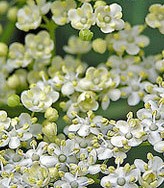 The European elder tree (Sambucus nigra) that produces elderflower for culinary use is native to most of Europe where it grows in both wet and dry, fertile soil, mostly in sunny sites. It is deciduous and grows up to thirty three feet tall but often sends up shoots and becomes shrub-like. The warty stems support dark green leaves that are pinnately compound with five to seven leaflets two to five inches long. The small creamy white flowers have five petals and are carried in lacy flat topped clusters up to seven inches in diameter for a couple of weeks in late spring. The fruits are dark purple to black berries, 1/3 inch across, and bitter when fresh.
The European elder tree (Sambucus nigra) that produces elderflower for culinary use is native to most of Europe where it grows in both wet and dry, fertile soil, mostly in sunny sites. It is deciduous and grows up to thirty three feet tall but often sends up shoots and becomes shrub-like. The warty stems support dark green leaves that are pinnately compound with five to seven leaflets two to five inches long. The small creamy white flowers have five petals and are carried in lacy flat topped clusters up to seven inches in diameter for a couple of weeks in late spring. The fruits are dark purple to black berries, 1/3 inch across, and bitter when fresh.
The fresh flowers have a narcotic fragrance and bitter taste but develop a licorice taste when cooked. The most common use of the flowers historically is as a cordial but they are also used to make wine and tea, and flavor foods such as baked goods, salad, jam, jelly, and marshmallows. Flowers should be collected early in the morning when in full bloom and allowed to dry on paper in a warm, dry, dark place. After the flowers are dry they can be stripped from the plant and made into a simple syrup for later use.
The history of the elder tree goes back to ancient times when both Hippocrates and Pliny mention it. In Christian times the elder was believed to be both the wood of the Cross of Calvary and the gallows for Judas. Perhaps as a result of its association with death and misfortune, the tree became surrounded by superstition in the Middle Ages. It became associated with funerals and was thought to ward off evil spirits and give protection from witches. People feared cutting down the trees or using them for firewood because of their magical properties. Yet the wood was used to make musical instruments, and small boys made the young shoots into pop guns by removing the pith. Various parts of the tree have been used medicinally for thousands of years to treat a variety of ills.